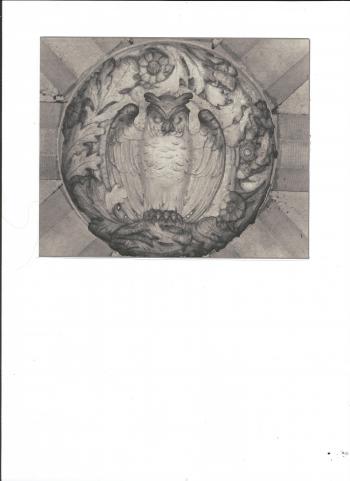Serendip is an independent site partnering with faculty at multiple colleges and universities around the world. Happy exploring!
The Owl and the Labyrinth


I chose the Owl, Protector of the College, because I have been so struck by how much energy surrounds the owl as well as her (and our) patron goddess Athena, in the college community. In shamanic terms the owl is not just a mascot, but a totem: an animal spirit which lends its special power to our tribe; and both by the length of Owl's association with Bryn Mawr (back at least to 1904 when Rockefeller Arch was built), and by the passion with which Bryn Mawr students seem to identify with her-- as well as the various rituals and superstitions associated with Athena, Owl's mistress-- she strikes me as quite uniquely powerful, compared to college mascots or totems that I have encountered elsewhere. In fact Athena, with all the attributes she carried as patroness of the ancient city of Athens (and still does carry-- myths do not die!), being such an important deity in ancient times, with her Owl, seems to embody just about all of what Bryn Mawr is about, what makes Bryn Mawr special and different; she seems to permeate all we do, and to give us her supervision and her blessings on a day to day basis.
The place I have chosen to revisit weekly during this course is the Labyrinth. Like the owl, the labyrinth is an ancient image, but compared to the owl it is a fairly recent arrival at Bryn Mawr. Like the owl, the image of labyrinth is an archetype which is always inside us, but unlike the owl it is also a physical practice one can engage in, in real time. It is a metaphor for the process of learning. A winding and laborious path leads from the entrance, frequently changing direction and doubling back on itself, perhaps frustratingly but inexorably leading to an arrival point at the center; along the way one has a constantly changing viewpoint on the surroundings; having arrived at a point only slightly different from where one started one must retrace one's steps back to the outside world, with the hope that the journey has made a subtle but significant alteration to our awareness. It seems like a good vantage point from which to observe the changes in Bryn Mawr's seasons.
I also like the labyrinth because it is not far from the house where my mother lived when she was a little girl. Number 210 Roberts Road, now occupied by adminstrative offices of some kind, was then a faculty residence, and my mother's mother taught history here for many years-- was in fact a notable personality in Bryn Mawr's own history. My mother, though she also went to Bryn Mawr as an undergraduate and as a graduate student, had a perhaps more than usually fraught relationship with her mother, who she remembers as dominating and selfish, not much interested in her children at all. Odd, then, that my father ended up teaching here, and Mother lived her entire adult life so near the scene of her unhappy childhood. And on some level, for me, my presence at Bryn Mawr now as a Mcbride Scholar has a great deal to do with untangling this ancestral riddle. Perhaps the labyrinth, if walked with intent, will help resolve that knot.


